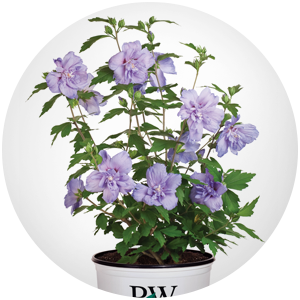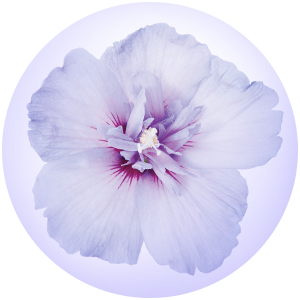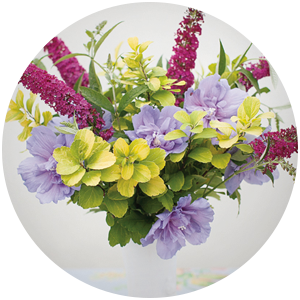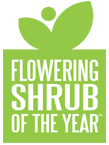BLUE CHIFFON®
hibiscus
Dreamy Blue Blossoms Gracing Your Garden
- Super floriferous with exquisite blue flowers
- Long blooming beginning midsummer
- Attracts pollinators but not deer
- Elegant, full shape is perfect for forming a hedge or living screen
- Low seed-set means no unwanted seedlings
- Strong grower in 6-8 hours of sun
- 8-12’ tall x 4-6’ spread
- Hardy in USDA Zones 5-9
True blue is a rare sight in the garden, but you’ll find it in the buds of this enchanting rose of Sharon shrub. They unfurl all along the stems to reveal large, lavender blue flowers with a fluffy anemone center. Bees and hummingbirds are frequent visitors as this robust flowering shrub is happy to provide them sustenance for months on end. Its impressive size, refined shape and durable nature make Blue Chiffon an ideal foundation plant when establishing or renovating a landscape design.
how to grow blue chiffon® hibiscus

Planting
Rose of Sharon’s strong, reliable character and intense flower power have made it one of the most popular landscape shrubs of all time. It is widely planted across North America since it is adaptable to many different growing conditions. No special soil is required except that it prefers those that are well-drained. Clay soil that drains reasonably well will do, as will lighter soils.
Choose a spot in your landscape that receives full sun, meaning at least 6-8 hours of sun per day. Don’t worry about it being too close to a sprinkler head, as this shrub can handle some dryness once established. Bear in mind that it will grow quite large, topping out at 12’ at maturity, so be sure to give it plenty of space to shine.
When planting, dig the hole about twice as wide but just as deep as the container it is growing in. If the roots are densely circled around when you take the plant out of the pot, loosen them up a bit to break the “root memory”. This will encourage them to grow outward instead of continuing to grow in a circular pattern.
Set the plant in the hole, making sure that the top of the rootball is level with the top of the surrounding soil. Then backfill the hole with the soil you dug out. Press it down with your hand firmly to eliminate any big air pockets around the roots.
Lastly, water the plant again to help the soil settle. Spread some mulch around the base of the plant, taking care to keep it from touching the plant’s stems. The mulch will help to retain soil moisture and protect the roots during winter.

Pruning
Blue Chiffon rose of Sharon blooms on “new wood”, meaning it forms its flower buds on the new growth the same year it blooms. Though heavy pruning shouldn’t be needed, the best time to do so is in early spring. We typically recommend trimming back no more than 1/3 of the stems so the shrub maintains a strong woody framework and enough foliage to make food for the roots.
If you are concerned that your rose of Sharon is going to outgrow its space, it’s better to transplant it to a larger spot in spring rather than prune it severely to try and limit its size. If you need something smaller, consider planting the 3-4’ tall Lil’ Kim® Violet rose of Sharon instead.
When you prune your rose of Sharon in spring, that’s also a good time to scratch some granular plant food formulated for trees and shrubs into the soil. Doing so will encourage it to start the season off strong. No additional feeding is necessary throughout the year.
You will notice that your rose of Sharon shrub tends to leaf out later in spring than many other plants. This is perfectly normal and not a cause for concern. It’s just how Hibiscus rolls. It makes up for its tardiness with exuberant growth in summer.

Uses
- Blue Chiffon rose of Sharon is ideal for anyone looking to fill a large space with a long blooming, flowering shrub that requires very little maintenance to thrive. If you are establishing a new garden or renovating the one you have to include plants that require less work, consider these easy care shrubs.
- Standing an impressive 8-12’ tall at maturity, Blue Chiffon makes a majestic hedge, screen or backdrop for a mixed border. Any sunny spot with well-drained soil will suffice. Wouldn’t you rather look at dreamy blue blossoms on a living screen all summer than watch your neighbor’s laundry drying on the clothesline?
- You could also position a single, impressive Blue Chiffon specimen up closer to the patio to bring the hummingbird show within view. It’s amazing how they will inspect each and every blossom until they’ve had their fill.
- To bring color to that part of the garden earlier in the season before Blue Chiffon starts its show, try planting a spring blooming tree nearby or earlier flowering perennials like Amazing Daisies® ‘Banana Cream’ and Color Spires® ‘Pink Dawn’ at its feet.
“I love this plant. I have it in blue and also in maroon. It’s 5 feet tall and has beautiful blue to purple flowers as they fade. I have several against the southern fence. I look foward to them blooming every year.”
–Julie, California
top 3 reasons to grow Blue Chiffon® Hibiscus
OH, THOSE BREATHTAKING BLUE BLOOMS!
What other plant could give you an 8-12’ tall solid wall of awe-inspiring blue blossoms for months on end?
BRING ON THE HUMMERS
It’s not just the dazzling flowers that will bring you joy every day. The hummingbird show has gotten rave reviews in gardens across North America, too.
THIS ROSE OF SHARON KNOWS HOW TO BEHAVE
If you’ve shied away from growing rose of Sharon because of unwanted seedlings in the past, you will appreciate Blue Chiffon’s very low seed-set and non-invasiveness.
Blue Chiffon® Hibiscus syriacus ‘Notwoodthree’ USPP20574 Can3583
